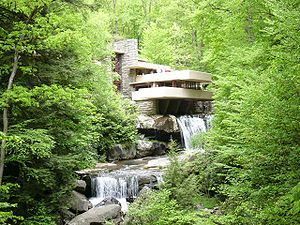Organic architecture
Organic architecture is a philosophy of architecture which promotes harmony between human habitation and the natural world through design approaches so sympathetic and well integrated with its site that buildings, furnishings, and surroundings become part of a unified, interrelated composition. Architects Gustav Stickley, Antoni Gaudi, Louis Sullivan, Frank Lloyd Wright, John Lautner, Claude Bragdon, Bruce Goff, Rudolf Steiner, Bruno Zevi, Hundertwasser, Imre Makovecz, Neville Gruzman and most recently Anton Alberts, Nari Gandhi, John Preihs and Laurie Baker are all famous for their work with organic architecture.
Organic architecture is also translated into the all inclusive nature of Frank Lloyd Wright’s design process. Materials, motifs, and basic ordering principals continue to repeat themselves throughout the building as a whole. The idea of organic architecture refers not only to the buildings' literal relationship to the natural surroundings, but how the buildings' design is carefully thought about as if it were a unified organism. Geometries throughout Wright’s buildings build a central mood and theme. Essentially organic architecture is also the literal design of every element of a building: From the windows, to the floors, to the individual chairs intended to fill the space. Everything relates to one another, reflecting the symbiotic ordering systems of nature.
The term organic architecture was coined by the famous architect, Frank Lloyd Wright (1867-1959), though never well articulated by his cryptic style of writing:
- "So here I stand before you preaching organic architecture: declaring organic architecture to be the modern ideal and the teaching so much needed if we are to see the whole of life, and to now serve the whole of life, holding no traditions essential to the great TRADITION. Nor cherishing any preconceived form fixing upon us either past, present or future, but instead exalting the simple laws of common sense or of super-sense if you prefer determining form by way of the nature of materials..." - Frank Lloyd Wright, written in 1939[1]
Other modernist architects in the U.S., Europe, and elsewhere held complementary and often competing views of how architecture could best emulate nature. Key figures in the U.S. included Louis Sullivan and Claude Bragdon, while among European modernists Hugo Haring and Hans Scharoun stand out. Following World War II, organic architecture often reflected cybernetic and informatic models of life, as is reflected in the later work of Buckminster Fuller.
Architect and planner David Pearson proposed a list of rules towards the design of organic architecture. These rules are known as the Gaia Charter for organic architecture and design. It reads:
"Let the design:
- be inspired by nature and be sustainable, healthy, conserving, and diverse.
- unfold, like an organism, from the seed within.
- exist in the "continuous present" and "begin again and again".
- follow the flows and be flexible and adaptable.
- satisfy social, physical, and spiritual needs.
- "grow out of the site" and be unique.
- celebrate the spirit of youth, play and surprise.
- express the rhythm of music and the power of dance."[2]
A well known example of organic architecture is Fallingwater, the residence Frank Lloyd Wright designed for the Kaufman family in rural Pennsylvania. Wright had many choices to locate a home on this large site, but chose to place the home directly over the waterfall and creek creating a close, yet noisy dialog with the rushing water and the steep site. The horizontal striations of stone masonry with daring cantilevers of colored beige concrete blend with native rock outcroppings and the wooded environment.
References
Bibliography
Aldersey-Williams, Hugh (2003). Zoomorphic: New Animal Architecture (London: Laurence King)
Ferre, Albert, et al., eds (2007). Verb Natures: Architectural Boogazine (Barcelona; New York: Actar)
Feuerstein, Günther (2002). Biomorphic Architecture: Human and Animal Forms in Architecture (Stuttgart; London: Axel Menges)
Gans, Deborah, and Zehra Kuz (2003). The Organic Approach to Architecture (New York; Chichester: Wiley)
Kolarevic, Branko (2000). 'Digital Morphogenesis and Computational Architectures', in Proceedigns of the 4th Confernece of Congreso Iberoamericano de Grafica Digital, SIGRADI 2000 - Construindo (n)o Espaço Digital (Constructing the Digital Space) [ISBN 85-88027-02-X], Rio de Janeiro (Brazil) 25-28 September 2000, ed. by José Ripper Kós, Andréa Pessoa Borde and Diana Rodriguez Barros, pp. 98-103 (http://cumincad.scix.net/data/works/att/4077.content.pdf)
Leach, Neil (2009). 'Digital Morphogenesis', Architectural Design, 79, 1, pp. 32-37
Menges, Achim (2007). 'Computational Morphogenesis: Integral Form Generation and Materialization Processes', in Proceedigns of Em‘body’ing Virtual Architecture: The Third International Conference of the Arab Society for Computer Aided Architectural Design (ASCAAD 2007), 28-30 November 2007, Alexandria, Egypt, ed. by Ahmad Okeil, Aghlab Al-Attili and Zaki Mallasi, pp. 725-744 (http://www.ascaad.org/conference/2007/057.PDF)
Menges, Achim (2006). 'Polymorphism', Architectural Design, 76, 2, pp. 78-87
O’Reilly, Una-May and Martin Hemberg (2007). 'Integrating Generative Growth and Evolutionary Computation for Form Exploration', Genetic Programming and Evolvable Machines, 8, 2, pp. 163-186
Pearson, David (2001). The Breaking Wave: New Organic Architecture (Stroud: Gaia)
Portoghesi, Paolo (2000). Nature and Architecture, trans. by Erika G. Young (London; Milan: Skira Editore; Thames & Hudson)
Roudavski, Stanislav (2009). 'Towards Morphogenesis in Architecture', International Journal of Architectural Computing, 7, 3, pp. 345-374 (http://www.crida.net/stan/Downloads/Roudavski_Towards_Morphogenesis_in_Architecture_09.pdf)
Steadman, Philip (2008). The Evolution of Designs: Biological Analogy in Architecture and the Applied Arts (New York: Routledge)
Senosiain, Javier (2003). Bio-architecture (Oxford, England: Architectural Press)
Tsui, Eugene (1999). Evolutionary Architecture: Nature as a Basis for Design (New York: John Wiley)
See also
- Romania Green Building Council
|
||||||||
